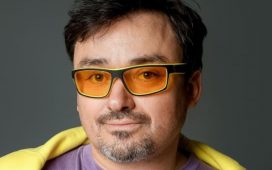Over and over during Sam Bankman-Fried’s trial, lawyers showed pictures of the FTX founder living his best life. There he was at the Super Bowl flanked by Katy Perry and Orlando Bloom. There he was on a private jet, sleeping with his hands folded. There he was onstage, in shorts and a T-shirt, with Bill Clinton and Tony Blair. The very traits that made him a cause célèbre in Silicon Valley—his intellect, his obsession with scale, his story—turned into liabilities. This evening, after deliberating for just a few hours, a jury found him guilty of all seven charges he faced, including counts of wire fraud, and conspiracy to commit money laundering and securities fraud.
Bankman-Fried’s charges together carry a maximum sentence of 110 years. Judge Lewis Kaplan, who oversaw the trial, is set to determine his sentence in March. Outside of the courthouse this evening, the U.S. attorney for the Southern District of New York, Damian Williams, told reporters that “this kind of corruption is as old as time.” Mark S. Cohen, Bankman-Fried’s lawyer, said in a statement, “We respect the jury’s decision. But we are very disappointed with the result. Mr. Bankman-Fried maintains his innocence and will continue to vigorously fight the charges against him.” He will likely appeal.
It’s a stunning turnaround for a man who sold a narrative that led his company, FTX, to be worth billions of dollars just one year ago. Stories undergird Silicon Valley, and Bankman-Fried was savvy enough to parlay his into what was, for a time, a wildly successful business. As a tech founder, “SBF” was straight out of central casting: unkempt, pedigreed, awkward in a way that has come to be a sign of brilliance. He replicated what investors, and the public, believed a founder should look like. But crucial to his narrative was the idea that he was a good guy, funneling his riches into causes such as effective-altruism that he believed would make the world a better place.
Tech welcomes big characters, and many successful founders become synonymous with their brands. In the “founder friendly” tech ecosystem, leaders tend to remain at the helm of their companies for many years—think of Mark Zuckerberg, who has been the CEO of Meta (previously Facebook) since its founding, or Jeff Bezos, who reigned as Amazon’s CEO for 27 years. Investors give money to ideas they believe in, but also to people they feel confident can lead. In this way, the story of a founder and the story of a company become intertwined.
Indeed, investors saw big potential in Bankman-Fried. Influential firms, including New Enterprise Associates, Softbank, Sequoia Capital, and BlackRock, collectively put $2 billion into FTX. Investors enthusiastically backed his company—and him. “I LOVE THIS FOUNDER,” a Sequoia partner wrote before the firm invested $214 million. (Sequoia swiftly wrote down its investment to zero dollars.) The fact that so many tech companies go years without turning a profit makes storytelling all the more crucial, Adrian Daub, a Stanford professor and the author of What Tech Calls Thinking, told me. The longer any company is not making money and running on fumes, the more important the stories a founder can tell investors become. A key dimension of Silicon Valley storytelling is the narrative of inevitability. Founders push the idea that they will become so big that the rules of the game will change for them, Daub said.
Storytelling, beyond its function for founders pitching investors, is useful for founders trying to sell their products to a public that may be baffled by what a new piece of technology means. Companies pitching products such as crypto rely on narratives to make tangible what is abstract. Founders have multiple audiences for their stories: investors, regulators, the public. To all three, Bankman-Fried was charming, in his way, and consistent. You can trust me, he seemed to say, I’m a nerd.
Of course, there is nothing wrong with an ambitious founder painting a vivid, optimistic picture of what their company can one day achieve. But in an industry that rewards explosive growth, founders may face more incentives to pump up the potential of their products than to make reasonable claims. (Remember Elizabeth Holmes and Theranos? Or Juicero?) Telling stories is one thing. Telling lies, as the jury determined Bankman-Fried did, is another. The incentive structures of Silicon Valley—and the huge sums that can be gained from selling stories rather than functional products—mean that the door remains open for other people to follow in his tracks. As long as “there’s a certain kind of company that requires this kind of storytelling,” Daub said, “and a certain kind of investor that needs that kind of company as a vehicle, there’s going to be another one.”
One unintended outcome of this fiasco, according to Margaret O’Mara, a historian at the University of Washington and the author of The Code: Silicon Valley and the Remaking of America, may be that founders shy away from getting involved in politics and philanthropy. (SBF, after all, pledged “north of $100 million” to defeat Donald Trump in 2024.) This scandal—and the intense amount of vitriol raining down on a founder who twisted idealism into fraud—might lead Silicon Valley’s power brokers to say, “This is what happens when we don’t stick to building,” O’Mara told me.
Tech investors still have a lot of money to invest, of course. Now that the crypto boom is over, they have set their sights on generative AI—–a technology that may be better defined than crypto but still has plenty of skeptics. Sam Altman, the controversial CEO of OpenAI, is an excellent spokesman for his company, O’Mara said. He has already appeared in Washington to present to lawmakers his version of the story of AI—one in which the technology is careening toward world-ending potential. “If history is any indication,” O’Mara said, investors and founders “will go full steam ahead.”











